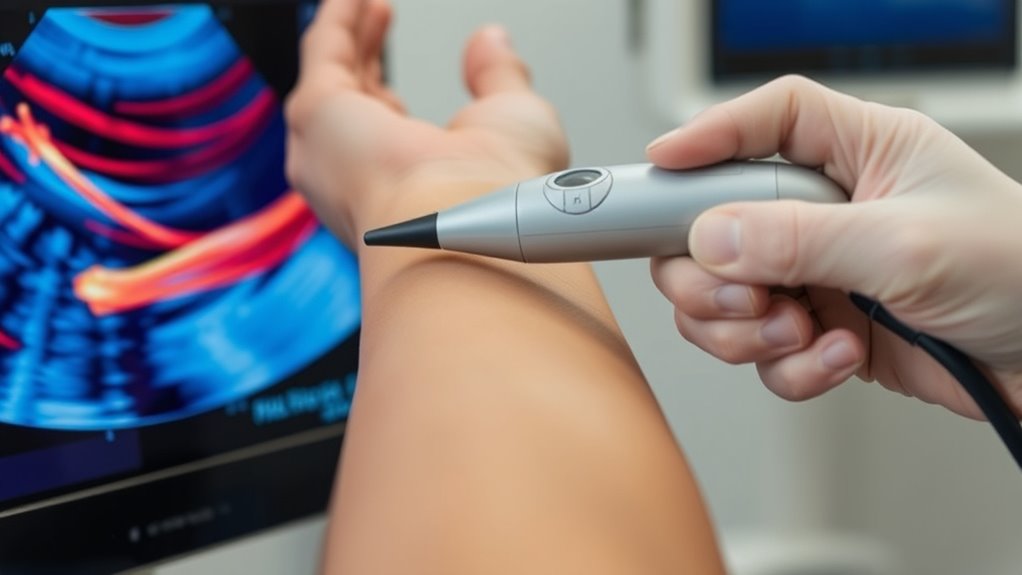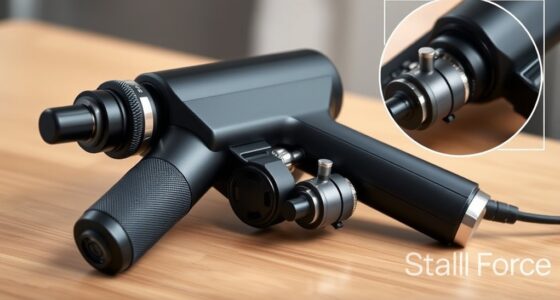Elastography is a non-invasive imaging technique that helps you see how stiff your muscles are. It works by sending gentle mechanical waves through your tissue and measuring how fast they travel—faster waves indicate firmer, stiffer muscles. This method provides real-time, detailed maps of muscle elasticity, making it easier to spot issues like strains or fibrosis. If you want to discover how this technology can benefit your health, keep exploring.
Key Takeaways
- Elastography is a non-invasive imaging technique that measures tissue stiffness by analyzing mechanical wave propagation through muscles.
- It creates detailed, color-coded maps highlighting regional differences in muscle elasticity and detects abnormalities like fibrosis or inflammation.
- The method uses gentle mechanical waves and measures their speed to determine tissue stiffness, with stiffer areas transmitting waves faster.
- Elastography provides real-time, functional insights into muscle health, aiding in diagnosis, monitoring, and guiding personalized treatments.
- It is safe, quick, and radiation-free, making it suitable for repeated assessments of muscle condition and effectiveness of therapies.

Have you ever wondered how doctors measure muscle stiffness accurately? It’s a fascinating process that relies heavily on advancements in diagnostic imaging, particularly a technique called elastography. Elastography is a non-invasive method that provides detailed insights into muscle elasticity, allowing physicians to assess how stiff or soft muscles are without needing surgery or biopsies. This technology works by sending gentle mechanical waves through the tissue and measuring how quickly they travel. Since stiffer tissues transmit these waves faster, elastography can create detailed maps that highlight variations in muscle stiffness across different regions. This capability is especially useful for diagnosing various muscular conditions, such as strains, tears, or chronic tightness, which can all alter the natural elasticity of muscle tissue.
The core principle behind elastography is its ability to visualize muscle stiffness in real time. Traditional imaging methods like MRI or ultrasound offer valuable structural information, but they don’t directly measure how elastic or stiff tissues are. That’s where elastography shines—it adds a layer of functional data to the anatomical images. When performed, the technique generates color-coded images that vividly display areas of increased or decreased stiffness, making it easier for physicians to identify problematic tissues. For instance, regions with reduced elasticity might indicate scar tissue or fibrosis, while areas with increased stiffness could suggest muscle tightness or inflammation. Because of this detailed information, elastography has become an essential tool in sports medicine, physical therapy, and rehabilitation.
Another advantage of elastography is its safety and convenience. Since it’s a form of diagnostic imaging that doesn’t involve radiation or injections, you can undergo the procedure multiple times without concern. The process is quick, usually taking just a few minutes, and offers immediate results that can guide treatment decisions. Doctors can monitor changes in muscle elasticity over time, helping them evaluate the effectiveness of therapy or detect early signs of deterioration. This real-time feedback enhances personalized treatment plans, ensuring you receive targeted interventions that restore muscle function more efficiently.
Frequently Asked Questions
How Accurate Is Elastography Compared to Other Muscle Imaging Techniques?
Elastography offers high diagnostic precision by providing a quantitative measurement of muscle stiffness, making it quite accurate compared to other imaging techniques. You can rely on it to detect subtle changes that might be missed with traditional methods like MRI or ultrasound alone. Its ability to quantify tissue properties helps you make more informed decisions, especially when monitoring muscle health or injury, making it a valuable tool in clinical assessments.
Can Elastography Detect Early Signs of Muscle Disease?
Yes, elastography can detect early signs of muscle disease, including muscle fibrosis. By measuring tissue stiffness, it helps you identify subtle changes before symptoms appear, making early diagnosis possible. This non-invasive technique allows you to monitor muscle health over time, catching issues early and guiding timely treatment. Its sensitivity to early tissue alterations makes elastography a valuable tool for improving patient outcomes.
Is Elastography Suitable for All Muscle Groups in the Body?
Elastography isn’t suitable for all muscle groups because of muscle group variability and imaging limitations. You may find it effective for superficial muscles like those in the arms and legs, but deeper or smaller muscles can be challenging to assess accurately. The technique’s accuracy depends on the muscle’s location and size, so you should consider these factors when using elastography for extensive muscle evaluation.
Are There Any Risks or Side Effects Associated With Elastography?
You might wonder if elastography has risks or side effects. Generally, it’s safe, with minimal chances of muscle fatigue or discomfort. However, some imaging limitations can affect accuracy, especially if the muscle is inflamed or injured. While rare, excessive pressure during the procedure could cause minor discomfort. Always consult your healthcare provider to confirm elastography is appropriate for your specific condition and to discuss any concerns.
How Long Does a Typical Elastography Muscle Assessment Take?
A typical elastography muscle assessment takes about 15 to 30 minutes, depending on the area being examined and the complexity of your condition. During the procedure, you’ll lie still while the technician performs the muscle assessment using the ultrasound device. The procedure duration is usually quick and non-invasive, allowing you to return to your daily activities immediately afterward. It’s an efficient way to evaluate muscle stiffness accurately.
Conclusion
Now that you understand elastography, you see how it captures muscle stiffness clearly, helping diagnose issues accurately. It reveals hidden tensions, uncovers silent injuries, and tracks recovery progress. It provides a window into your muscles’ health, guiding your treatment and rehabilitation. By visualizing what’s beneath the surface, elastography empowers you to take control, make informed decisions, and move forward with confidence. It’s a tool that transforms imaging into insight, restoring your strength and vigor.









